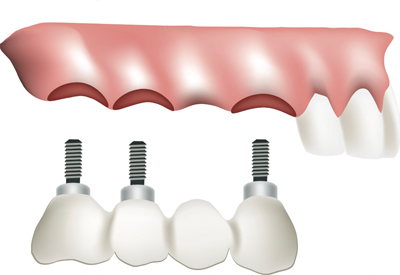Dental Implants Implants 101 Implants vs Dentures Single Missing Tooth
Multiple Missing Teeth Implant Supported Dentures Are Implants Right For Me? Implants FAQ
Modern dentistry now views dental implants as the standard of care for replacing multiple teeth, particularly when they are in a row. Implants play a crucial role in preventing bone loss and preserving facial structure. Former treatments, such as dentures, not only failed to address these concerns, but in fact led to complications.
Dental Implants vs Traditional Dental Bridge
A partial bridge is the most common solution for replacing multiple lost teeth; however, it is no longer considered the best treatment. The structural components of a bridge inflict permanent damage on the remaining teeth acting as anchors to support the bridge. Studies have shown that bridges often lead to additional tooth loss caused by wear and tear on what would otherwise have been healthy teeth.
Dental bridges allow the jaw bone to deteriorate because they do not stimulate the bone, whereas the roots of dental implants provide stimulation, protecting the jaw bone and supporting existing facial structure and shape. Because the titanium is compatible with the body, it is able to integrate into the jaw bone for a stronger replacement, increasing the permanency and longevity of the implant. Additionally, because the implant cannot be removed without of surgery, complications such as looseness or slipping are eliminated, allowing for normal eating and speaking.
Restoring Your Smile
 Many factors contribute to the placement of implants in multiple teeth replacements. The first approach your doctor will consider is to place an implant at the site of each lost tooth. Such implants would be permanent replacements and act as your natural teeth. Not all patients qualify for implants at all sites of tooth loss. If too much bone loss has occurred, bone grafting may be necessary to create sufficient bone mass to hold the dental implant.
Many factors contribute to the placement of implants in multiple teeth replacements. The first approach your doctor will consider is to place an implant at the site of each lost tooth. Such implants would be permanent replacements and act as your natural teeth. Not all patients qualify for implants at all sites of tooth loss. If too much bone loss has occurred, bone grafting may be necessary to create sufficient bone mass to hold the dental implant.
Another option is to use implants to create an implant supported bridge. Similar to traditional bridges, a prosthetic attaches to two abutment teeth; however, with dental implants, the anchor teeth are implants rather than remaining natural teeth. This reduces the risks of damage or loss of your remaining teeth.
During the procedure, two or more implants are placed with a temporary replacement, called a “flipper,” suspended between them for the duration of the healing period, which takes 4-6 months. Once the implants have fused with the jaw bone, the procedure is completed by attaching the permanent prosthetic between the implanted anchor teeth.
Next: Implant Supported Dentures>>